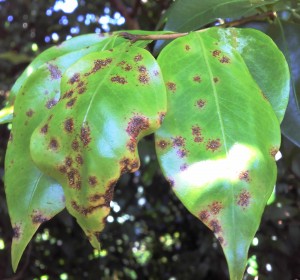Myrtle Rust Saga Continues…
 Back in March’s issue I wrote an article about Myrtle Rust Uredo rangelii, that nasty little fungal pathogen that arrived on the range just over two years ago and wreaked havoc on many of our local rainforest myrtles. We’d just had the longest period (since its arrival 2 years ago) without Myrtle Rust damaging the new growth of our Myrtles which spurred me on to write a positive and glowing article about the “balance of nature” and “ ecological equilibrium” being reached and that perhaps Myrtle Rust was not going to be that much of a problem after all…
Back in March’s issue I wrote an article about Myrtle Rust Uredo rangelii, that nasty little fungal pathogen that arrived on the range just over two years ago and wreaked havoc on many of our local rainforest myrtles. We’d just had the longest period (since its arrival 2 years ago) without Myrtle Rust damaging the new growth of our Myrtles which spurred me on to write a positive and glowing article about the “balance of nature” and “ ecological equilibrium” being reached and that perhaps Myrtle Rust was not going to be that much of a problem after all…
Well obviously Myrtle Rust can read, and very much took umbrage at my theory and decided to launch a full scale campaign to prove I didn’t know what on earth I was going on about and that there was plenty of fight left in this invading fungi yet – thank you very much! Within days of the March HT hitting the news counters, Myrtle Rust was flexing its muscle and I was thinking to myself that I should really sit on some of these ideas a bit longer and watch what happens next!
I guess the crux of this story (as I write this) is that Myrtle Rust hasn’t gone away. Generally the severity of infection appears to have lessened on many of the plants that have been hit previously. However (and it’s a big however) a new disturbing trend of the current flare up of infection over the last month or two, is that it is apparent on a much wider range of species in the wild including Eucalypts and Melaleucas (that in the past haven’t shown signs of infection, locally, in the wild).
So to sum up, the severity of the infection (my observation) has lessened on many plants previously hit, but Myrtle Rust has thrown a much wider net and is appearing on many, many more Myrtle species in the wild. The story of this nasty little invader is far from over and could range from complete apocalypse and collapse of the Myrtle based forests of Australia through to “balance of nature” being restored and all being hunky dory… or perhaps somewhere in between.
So what should you do to treat Myrtle Rust infection of your favourite plants? Pruning damaged foliage stimulates sappy new growth which is even more susceptible to infection. Fungicides will effectively kill Myrtle Rust on your favourite plants but are not a cure and need to be applied regularly as a preventative and in the long term Myrtle Rust may well develop immunity to these chemicals. Selecting resistant plants and organic and diverse, natural plantings are as always the best solution!
